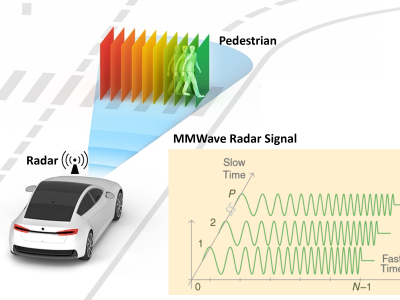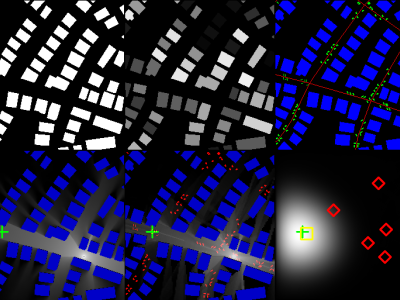CRAWDAD tools/analyze/link/PBProbe

- Citation Author(s):
-
Ling-Jyh Chen (Academia Sinica, Institute of Information Science)Wei-Xian Lee (Academia Sinica, Institute of Information Science)
- Submitted by:
- CRAWDAD Team
- Last updated:
- DOI:
- 10.15783/C7W013
- Data Format:
 263 views
263 views
- Categories:
Abstract
PBProbe - a link capacity estimation tool for network links.
PBProbe is a link capacity estimation tool that supports a wide range of links, including high speed links, asymmetric links, and wireless links. The tool is based on the CapProbe algorithm excepts that it uses a “packet bulk” to adapt the number of packets in each probing according to different network characteristics. As a result, it preserves the simplicity, speed, and accuracy of CapProbe, and compensates for the poor system timer granularity problem that may cause problems on high speed links. Compared to other capacity estimation techniques, PBProbe is ideal for real deployments that require online and timely capacity estimation, and it can facilitate various applications, such as peer-to-peer streaming and file sharing, overlay network structuring, pricing and QoS enhancements, as well as network monitoring.
Lastmodified :
2012-11-12Dataname :
tools/analyze/link/PBProbeFile :
PBProbe_2.0.1.tar.gzReleasedate :
2012-10-24Equiversion :
2.0.1Change :
the initial version.References :
chen:pbprobe WebsiteWebsite :
http://www.crawdad.org/tools/analyze/link/PBProbeKeyword :
802.11 802.11a 802.11b 802.11gLicense :
Copyright (c) 2012 Ling-Jyh Chen Permission is hereby granted, free of charge, to any person obtaining a copy of this software and associated documentation files (the "Software"), to deal in the Software without restriction, including without limitation the rights to use, copy, modify, merge, publish, distribute, sublicense, and/or sell copies of the Software, and to permit persons to whom the Software is furnished to do so, subject to the following conditions: The above copyright notice and this permission notice shall be included in all copies or substantial portions of the Software, and if the Software or part of it is implemented or applied in academia research and publication, the article "Ling-Jyh Chen, Tony Sun, Bo-Chun Wang, M. Y. Sanadidi, and Mario Gerla. PBProbe: A Capacity Estimation Tool for High Speed Networks. Computer Communications Journal, Elsevier, volume 31, number 17, pp. 3883-3893, November, 2008." related to the Software should also be properly cited in the reference. THE SOFTWARE IS PROVIDED "AS IS", WITHOUT WARRANTY OF ANY KIND, EXPRESS OR IMPLIED, INCLUDING BUT NOT LIMITED TO THE WARRANTIES OF MERCHANTABILITY, FITNESS FOR A PARTICULAR PURPOSE AND NONINFRINGEMENT. IN NO EVENT SHALL THE AUTHORS OR COPYRIGHT HOLDERS BE LIABLE FOR ANY CLAIM, DAMAGES OR OTHER LIABILITY, WHETHER IN AN ACTION OF CONTRACT, TORT OR OTHERWISE, ARISING FROM, OUT OF OR IN CONNECTION WITH THE SOFTWARE OR THE USE OR OTHER DEALINGS IN THE SOFTWARE.Support :
We will be happy to answer any questions via emails regarding this tool.Build :
To build the tool: - Unpack files: tar xvfz PBProbe-2.0.1.tar.gz - Compile code: cd ./PBProbe-2.0.1 & makeOutput :
Final: <Link Capacity (Mbps)> <Packet Loss> <Packet Recv> <Packet Loss Rate(%)> <Elapsed Time (seconds)> Example: Final: 97.48257 0 20200 0.00 2.99025Parameters :
All Options: -s: run as sender, ex: '-s RECEIVER_IP' -d: run as receiver, ex: '-d SENDER_IP' -p: the size of packet (default: 1500), ex: '-p 1000' means using 1000 bytes as a packet -c: the interval of probing traffic, ex: '-c 100' means constant interval 100 ms -r: the rate to probe the link capacity, ex: '-r 1' means using 1 Mbps to probe -k: the length of bulk (default: 10), ex: '-k 100' means a bulk contains 100 packets -u: the utilization of link capacity (default: 0.01), ex: '-u 0.01' means using 1% of link capacity to probe -n: the number of probing bulks (default: 10), ex: '-n 200' means using 200 bulks to probe -v: show verbose log -b: show debug info Note: 1) You just can use one of '-c', '-r' and '-u' option at a time. 2) If you try to measure the high speed link such as 1 Gbps link, you can use '-k 100' for more accurate. The default length of bulk is 10.Usage :
To estimate the link capacity between two nodes called Sender and Receiver, you can follow the instructions below. <At Sender> ./PBProbe –s <Receiver_IP> <At Receiver> ./PBProbe –d <Sender_IP> If your link is a high speed link which is higher than 1 Gbps, you can use ‘-k 100’ or even ‘-k 1000’ for more accuracy. The default k is 10. If your link is a slow speed link, you can use ‘-r <rate>’ to limit the probing traffic. If the packet size becomes larger than the Maximum Transmission Unit (MTU), the “big” packet will be segmented into several fragments before entering the network. The fragments will then be reassembled as the original packet size at the receiver. The latency caused by segmentation (at the sender) and reassembly (at the receiver) expands the dispersion measurement and therefore results in underestimation. You can use ‘-p <packet_size>’ to change the packet size to probe the link. After the estimation, PBProbe will return the link capacity, packet loss, packets received, packet loss rate, and elapsed time. If you want to know the detailed dispersion in the experiment, you can use ‘-v’ for more information.Example :
There are examples of input and output on the tool website http://sourceforge.net/projects/pbprobe/Algorithm :
PBProbe estimates the link capacity by actively sending a number of probes over the network and using the minimum delay sum filter to identify a “good” sample. However, instead of employing a packet pair, PBProbe uses a packet bulk of length k in each probing and measures the capacity of each direction separately. Specifically, PBProbe is comprised of two phases. In the first phase, it estimates the capacity of the forward link; and in the second, it estimates the capacity of the backward link. For more detail, you can refer to our article in Computer Communications Journal.Instructions:
The files in this directory are a CRAWDAD toolset hosted by IEEE DataPort.
About CRAWDAD: the Community Resource for Archiving Wireless Data At Dartmouth is a data resource for the research community interested in wireless networks and mobile computing.
CRAWDAD was founded at Dartmouth College in 2004, led by Tristan Henderson, David Kotz, and Chris McDonald. CRAWDAD toolsets are hosted by IEEE DataPort as of November 2022.
Note: Please use the tools in an ethical and responsible way with the aim of doing no harm to any person or entity for the benefit of society at large. Please respect the privacy of any human subjects whose wireless-network activity is captured by the tools and comply with all applicable laws, including without limitation such applicable laws pertaining to the protection of personal information, security of data, and data breaches. Please do not apply, adapt or develop algorithms for the extraction of the true identity of users and other information of a personal nature, which might constitute personally identifiable information or protected health information under any such applicable laws. Do not publish or otherwise disclose to any other person or entity any information that constitutes personally identifiable information or protected health information under any such applicable laws derived from the tools through manual or automated techniques.
Please acknowledge the source of the tools in any publications or presentations reporting use of this tools.
Citation: Ling-Jyh Chen, Wei-Xian Lee, CRAWDAD toolset tools/analyze/link/PBProbe (v. 2012-10-24), https://doi.org/10.15783/C7W013, Oct 2012.
















